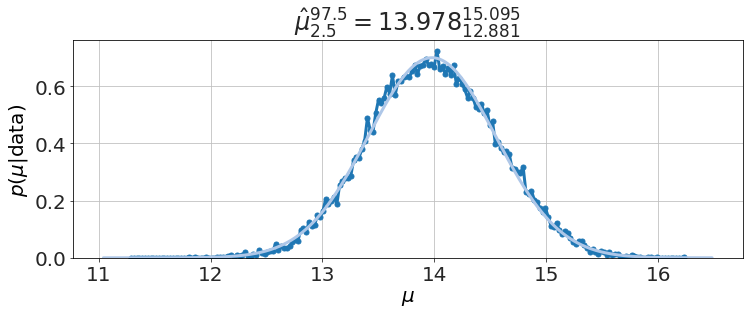
Gravitational Attraction
What would happen if two people out in space a few meters apart, abandoned by their spacecraft, decided to wait until gravity pulled them together? My initial thought was that …
In #math

I'd like to walk through some of the "Statistics 101" examples (e.g. estimating <math xmlns="http://www.w3.org/1998/Math/MathML"><semantics><mrow><mi>μ</mi></mrow><annotation encoding="application/x-tex">\mu</annotation></semantics></math> with known <math xmlns="http://www.w3.org/1998/Math/MathML"><semantics><mrow><mi>σ</mi></mrow><annotation encoding="application/x-tex">\sigma</annotation></semantics></math>, estimating a proportion, etc...) for which we have simple analytical solutions, but explore them with MCMC. The reason I want to do this is to introduce MCMC on simple cases, which are not much different than more complicated cases, but are better understood. The second reason is to explore some cases which are nearly as easy, but are never covered in introductory textbooks. In all of these I'm going to use a python library I make for my science-programming class, stored on github, and the emcee library. Install like:
pip install "git+https://github.com/bblais/sci378" --upgrade
pip install emcee
We'll start with the easiest example: there is some true value, we call <math xmlns="http://www.w3.org/1998/Math/MathML"><semantics><mrow><mi>μ</mi></mrow><annotation encoding="application/x-tex">\mu</annotation></semantics></math>. The <math xmlns="http://www.w3.org/1998/Math/MathML"><semantics><mrow><mi>N</mi></mrow><annotation encoding="application/x-tex">N</annotation></semantics></math> data points we have, <math xmlns="http://www.w3.org/1998/Math/MathML"><semantics><mrow><mo stretchy="false">{</mo><msub><mi>x</mi><mi>i</mi></msub><mo stretchy="false">}</mo></mrow><annotation encoding="application/x-tex">\{x_i\}</annotation></semantics></math>, consist of that true value with added independent, normally-distributed noise of known scale, <math xmlns="http://www.w3.org/1998/Math/MathML"><semantics><mrow><mi>σ</mi></mrow><annotation encoding="application/x-tex">\sigma</annotation></semantics></math>.
For a Bayesian solution, we need to specify the likelihood function -- how our model produces the data -- and the prior probability for the parameters. The likelihood function is determined like
<math display="block" xmlns="http://www.w3.org/1998/Math/MathML"><semantics><mtable columnalign="right left" columnspacing="0em" rowspacing="0.25em"><mtr><mtd><mstyle displaystyle="true" scriptlevel="0"><msub><mi>x</mi><mi>i</mi></msub></mstyle></mtd><mtd><mstyle displaystyle="true" scriptlevel="0"><mrow><mrow></mrow><mo>∼</mo><mi>μ</mi><mo>+</mo><msub><mi>ϵ</mi><mi>i</mi></msub></mrow></mstyle></mtd></mtr><mtr><mtd><mstyle displaystyle="true" scriptlevel="0"><mrow><mi>P</mi><mo stretchy="false">(</mo><msub><mi>x</mi><mi>i</mi></msub><mi mathvariant="normal">∣</mi><mi>μ</mi><mo separator="true">,</mo><mi>σ</mi><mo stretchy="false">)</mo></mrow></mstyle></mtd><mtd><mstyle displaystyle="true" scriptlevel="0"><mrow><mrow></mrow><mo>∼</mo><mtext>Normal</mtext><mo stretchy="false">(</mo><msub><mi>x</mi><mi>i</mi></msub><mo>−</mo><mi>μ</mi><mo separator="true">,</mo><mi>σ</mi><mo stretchy="false">)</mo></mrow></mstyle></mtd></mtr><mtr><mtd><mstyle displaystyle="true" scriptlevel="0"><mrow><mi>P</mi><mo stretchy="false">(</mo><mo stretchy="false">{</mo><msub><mi>x</mi><mi>i</mi></msub><mo stretchy="false">}</mo><mi mathvariant="normal">∣</mi><mi>μ</mi><mo separator="true">,</mo><mi>σ</mi><mo stretchy="false">)</mo></mrow></mstyle></mtd><mtd><mstyle displaystyle="true" scriptlevel="0"><mrow><mrow></mrow><mo>∼</mo><munder><mo>∏</mo><mi>i</mi></munder><mtext>Normal</mtext><mo stretchy="false">(</mo><msub><mi>x</mi><mi>i</mi></msub><mo>−</mo><mi>μ</mi><mo separator="true">,</mo><mi>σ</mi><mo stretchy="false">)</mo></mrow></mstyle></mtd></mtr></mtable><annotation encoding="application/x-tex"> \begin{aligned} x_i &\sim \mu + \epsilon_i \\ P(x_i|\mu,\sigma) &\sim \text{Normal}(x_i-\mu,\sigma) \\ P(\{x_i\}|\mu,\sigma) &\sim \prod_i \text{Normal}(x_i-\mu,\sigma) \end{aligned} </annotation></semantics></math> known <math xmlns="http://www.w3.org/1998/Math/MathML"><semantics><mrow><mi>σ</mi></mrow><annotation encoding="application/x-tex">\sigma</annotation></semantics></math>
In the "Statistics 101" examples, the results are typically equivalent to uniform priors on the parameters, so we'll assume uniform priors on <math xmlns="http://www.w3.org/1998/Math/MathML"><semantics><mrow><mi>μ</mi></mrow><annotation encoding="application/x-tex">\mu</annotation></semantics></math>.
def lnlike(data,μ):
# known σ
x=data
return lognormalpdf(x,μ,σ)
data=array([12.0,14,16])
σ=1
model=MCMCModel(data,lnlike,
μ=Uniform(-50,50),
)
now we run MCMC, plot the chains (so we can see it has converged) and look at distributions,
model.run_mcmc(800,repeat=3)
model.plot_chains()
Sampling Prior...
Done.
0.21 s
Running MCMC 1/3...
Done.
2.23 s
Running MCMC 2/3...
Done.
2.24 s
Running MCMC 3/3...
Done.
2.51 s

model.plot_distributions()

compare to textbook solution (i.e. Normal with deviation <math xmlns="http://www.w3.org/1998/Math/MathML"><semantics><mrow><mi>σ</mi><mi mathvariant="normal">/</mi><msqrt><mi>N</mi></msqrt></mrow><annotation encoding="application/x-tex">\sigma/\sqrt{N}</annotation></semantics></math>),
x,y=model.get_distribution('μ')
plot(x,y,'-')
μ̂=mean(data)
N=len(data)
σμ=σ/sqrt(N)
y_pred=[exp(lognormalpdf(_,μ̂,σμ)) for _ in x]
plot(x,y_pred,'r--')

and finally find a tail-area probability, the Bayesian equivalent to Z-test,
model.P('μ>15')
0.037066666666666664
This simple example can be a template for more complex problems, which I will explore in later posts of this series. What do you think?